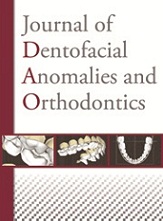No CrossRef data available.
Article contents
ORTHODONTIC-ORTHOPEDIC and OTOLYRNGOLOGICAL treatment of “facial insufficiency” and hyperdivergence
Published online by Cambridge University Press: 31 May 2011
Abstract
In treating children who have a significant lack of space both for the correct placement of their teeth, in what is called an arch length discrepancy, as well as for proper accommodation of their airways resulting in the Obstructive Sleep Apnea Syndrome, it seems to us to be indispensable for specialists in dentofacial orthopedics and otolaryngology to share and combine their philosophies and treatment approaches. The three clinical cases that we are presenting in a virtually documentary cinemaphotographic fashion, dealing simultaneously with the skeletal, dental, and breathing aspects of the disorder, will, we hope, give an improved view of the landmarks and architecture of “facial insufficiency” and the ways in which it can be treated. Patients with “facial insufficiency” suffer from simultaneous impairment of the correct growth off the two maxillae. In addition, the failure of the two jaws to develop sagittally makes the problem difficult to detect. Patients with Class I bimaxillary retrusions make up the majority of patients seeking orthodontic treatment who have facial insufficiency. And it is only the oral examination the orthodontist makes about the lack of space for teeth that uncovers the accompanying problem of lack of space for the airways. It should be pointed out that not all patients with bimaxillary retrusions have insufficient airway space. Still orthopedic treatment of the dental problem, enlarging available space in the dental arches, also automatically increases available airway space. This procedure must await the restart of vertical posterior growth under the influence of upward pressure from the tongue against palatal supports that stimulate the mandibular condyles. It is understandable, then, that any blockage of nasal breathing, from, for example the inferior turbinates or enlarged adenoidal tissue or impediment to vertical tongue thrusts, from excess tonsilar tissue or tight lingual frenums would be a primary hindrance to the desired growth process. So the first orthodontic objective is freeing the tongue, the second is adjusting occlusion. Ramus growth, in fact, unlocks a verticotransverse “raising” action of the lower lateral sectors needed for occlusal recovery and advancement of the maxilla. The “mandibular lock” blocking maxillary advancement is thus opened vertically.
Keywords
- Type
- Research Article
- Information
- Journal of Dentofacial Anomalies and Orthodontics , Volume 13 , Issue 4: Varia , December 2010 , pp. 340 - 380
- Copyright
- © RODF / EDP Sciences


